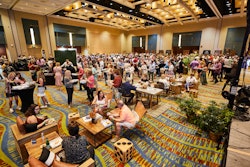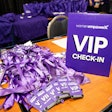
 Karen DanielePhoto: Courtesy of Karen Daniele
Karen DanielePhoto: Courtesy of Karen Daniele
So, where do you start when designing your sponsorship program? Here are five do’s and don’ts...
1. Don’t be transactional.
Your events will be more successful—and your sponsorship sales program more lucrative—if you start thinking about all your audiences in terms of a three-way symbiotic relationship: You as an organizer want to grow your audience. Your sponsors want access to that audience. And the audience wants unique and impactful experiences with which to engage.
Often, conference sales tend to be transactional. In other words, sponsors give you money, and you provide them with leads and branding. But it shouldn’t be that way. The pandemic was a wake-up call. With in-person events shuttered, sponsors realized how much they depend on conferences, trade shows, and other in-person events for building a pipeline. And attendees recognized the need to interact with brands in different ways. These changes make clear the need to go beyond the transactional and create more customized sponsor packages that better address the needs of your attendee.
2. Do extend the show environment.
So, how do you create new and different activations and experiences that engage your audience beyond the traditional show floor and regular conference hours? Look outside the convention center box. Explore the environment and city around you. Extend your event campus—both spatially and temporally—beyond the traditional confines. Create experiences that provide avenues of exploration and connection. Perhaps it’s a bourbon tasting at a local cocktail bar or a puppy play park in a green space around the meeting facility.
At a recent conference, a sponsor had an artist build a temporary art installation across from the convention center. It used recycled materials and evolved over the multiday event. It was a brilliant way to draw attendees back again and again to check on the artist’s progress.
At another event, the organizer and sponsors took over storefronts on a street adjacent to the conference center, allowing them to brand the outside and reconfigure the interiors to cater to attendees. It was a fun way to extend the event footprint, making attendees feel they were part of it, even on their way to and from the conference. It also took the burden off the event organizer by allowing sponsors to customize and develop their own spaces.
Event organizers are sometimes reluctant to invest in these kinds of extensions. But once they try it, they find it increases revenue potential, turns audiences into advocates, and creates the social buzz that fuels retention and growth.
3. Do create special moments.
More than ever, people understand the value of connection and engagement. And although this has always been an element of sponsorships, attendees are looking for more. There’s a lot you can do to build in flexibility, so sponsors can get involved in developing customizable activations that allow their brand personalities to shine while providing attendees opportunities to connect over shared experiences, hobbies, and interests.
To get those connections, you have to go broader than in the past. Instead of the usual doughnut wall or mosaic of attendee selfies, try mixing it up a bit. For instance, share a common interest of your attendees. One recent event included a ski simulator that allowed people to bond over sharing favorite ski destinations around the world.
The point is to get away from slapping more corporate logos on more surfaces and instead create unique moments for attendees.
4. Don’t be one of many.
Medal-level sponsor packages don’t pack the punch they used to. Sponsors are tired of being one of five or 10 other companies divvying up that exposure. To help your sponsors gain more visibility and create more impact, create one-of-one opportunities. For example, if a sponsor is attempting to elevate women in tech, being the sole sponsor of a Women in Tech luncheon will have a much greater impact because it aligns their values with those of the attendees, and allows that sponsor to own a specific message that will resonate more deeply.
This isn’t to say you don’t still cover your basic gold, silver, and bronze packages. But you also build in flexibility to allow sponsors’ brands and strategic initiatives to shine. And don’t be afraid to create more of these unique sponsored opportunities. They won’t dilute the brand of you—the organizer. Instead, if attendees gain more memorable experiences, they’ll associate that experience with the event overall (and the sponsor), which will boost your NPS score.
5. Do focus on retention.
Retention is every event producer’s dream—the closer to 100% return for sponsors, the better. It makes your job easier for the next year and provides a platform for future growth. It’s easier said than done, but capitalizing on show momentum while on site can be the key.
How? By creating a sales rebooking process during the program, you can harness the excitement of your program. Nth Degree Events helped many clients achieve a 90% sponsor rebook on site using just such a process. We also leverage exhibitor advisory boards that provide feedback for the next year. And we ask sponsors to participate in creating opportunities that they want to see and pay for. In one instance, a sponsor we worked with came up with an amazing gold-level sponsorship idea and then was willing to pay top dollar to secure it for themselves.
Take a more holistic and personalized approach to your sponsorship program. How much money you bring in on a particular activation should not be your prime concern. An event is about connections and community. If you think about creating special moments for attendees and sponsors, expanding your show footprint, and offering personal connections throughout your event, you’ll be on the right path to increasing your program’s revenue, boosting sponsor engagement, and growing your audience.



















